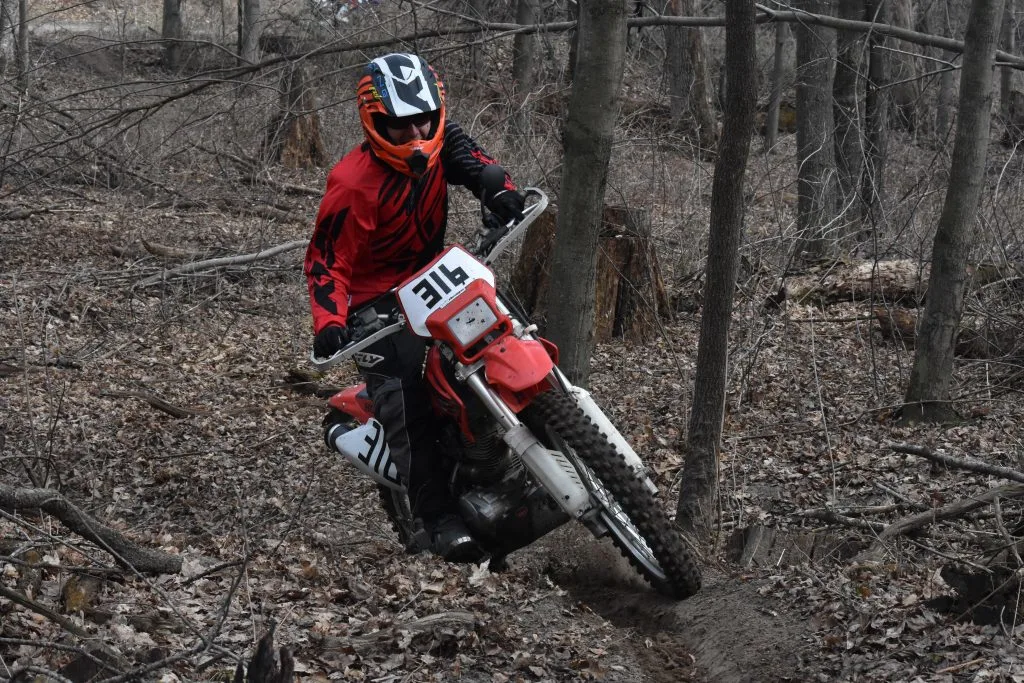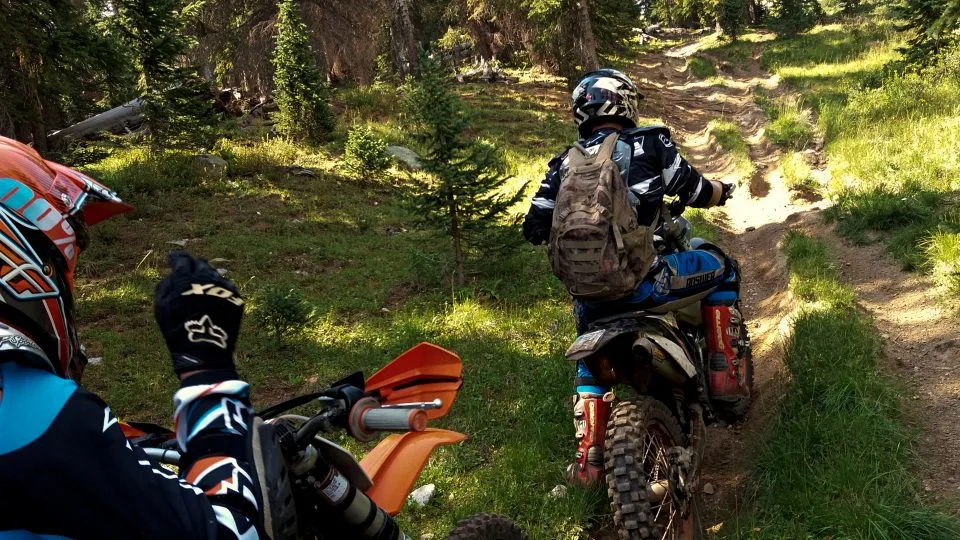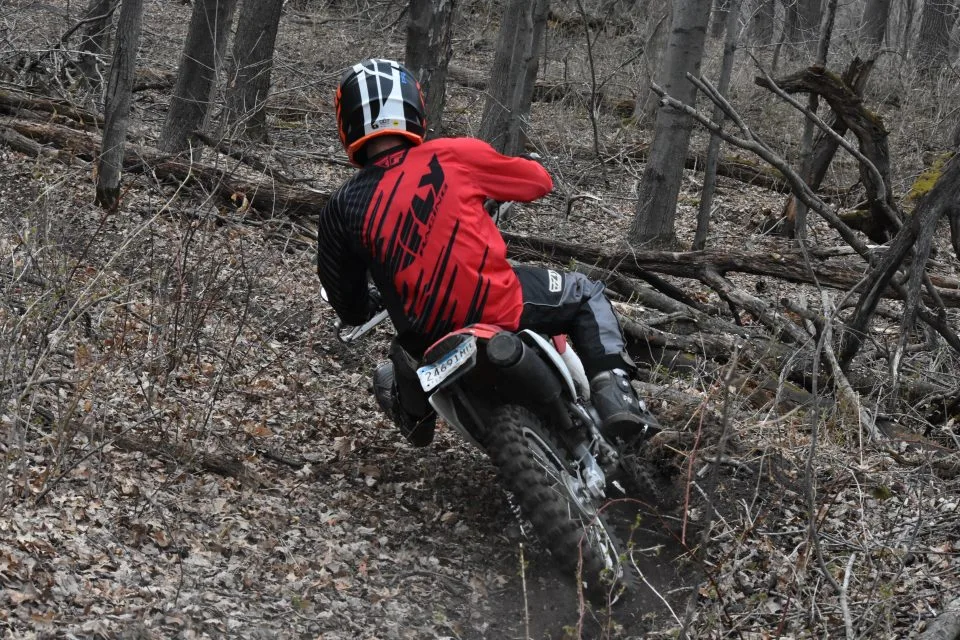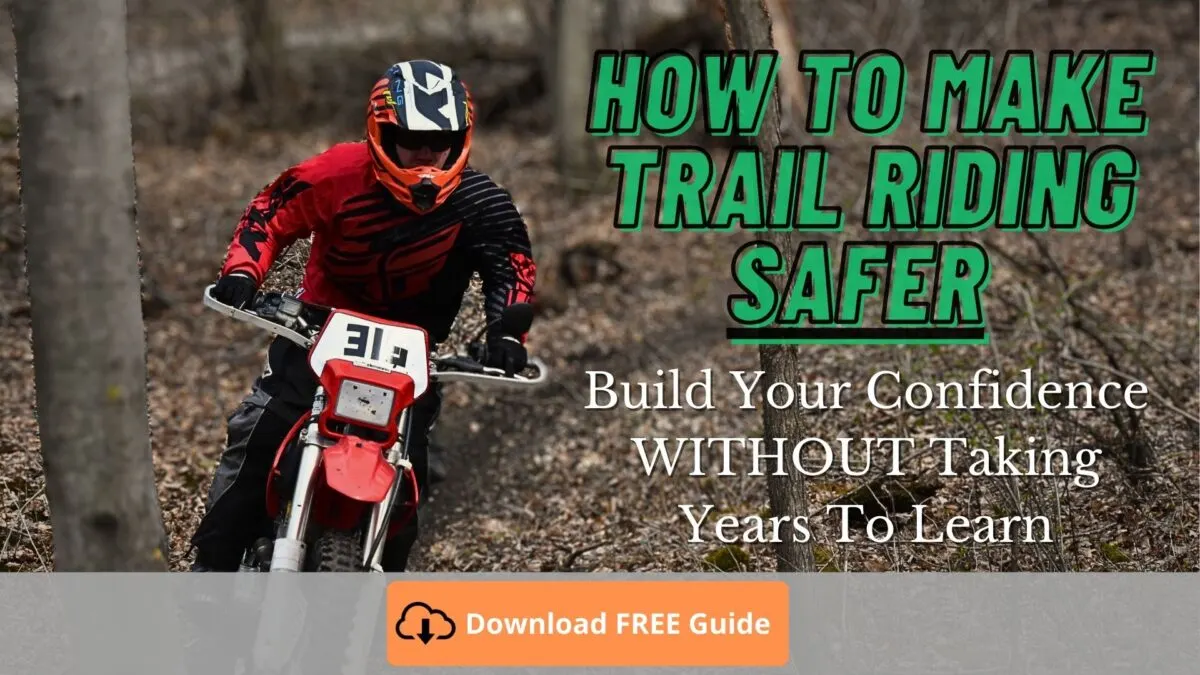Are you an avid trail rider that wants to improve your skill and speed? Maybe you're just starting out and want to know what the best trail riding riding tips are for beginners, or you just want to be faster than your buddies.
This is my ultimate list of dirt bike trail riding and enduro tips for beginners or advanced riders.
These are the very tips and techniques that I've learned, either by failure and learning or being taught. They're all practical and easy to implement.
The first half of my tips are more general and are either mindset or need-to-know tips. The other half are for improving your riding technique.

Here's my top off-road riding tips if you're new to dirt biking:
- Start on the right bike
- Go to a local trail ride
- Setup your dirt bike for you
- Maintain a reliable bike
- What protective gear is necessary
- How to make mistakes and keep growing
- Ask for advice
- Take advice
- Ride with faster rider (there’s always someone faster)
- Have fun
- Look ahead
- Finger on brake and clutch
- Standing up
- No brake for momentum
- Efficiency, less shifting, practice clutch in corners
- Smooth throttle for traction and endurance
- Smooth is fast
- Stay loose but tight
Start On The Right Dirt Bike
Are you a beginner when it comes to dirt biking? Then you need to start out on a bike that isn't going to wrap you around a tree…
Too many newbies go out and buy a 450 4 stroke or 300cc 2 stroke enduro bike and think they can "grow into it."
What really happens is arrogant Tim thinks he can handle all that power because he can shift through all the gears in a straight line. Then once he gets on some single track trails, the snappy torque is just too much.
His hands are getting tired, it's hard to hang on or pull in the clutch and brake levers.
He clearly sees a tree coming that's almost in the trail. Riding a little bit too fast, so it's time to hit the brakes. Whoops, your hand slips and twists the throttle just a little bit and the very tree that Tim was trying to miss is what he rides his new 450 right into.
Don't Be Like Tim
Tim was proud of his fast bike. Tim was a beginner. Tim was a fool. Don't be like Tim.
You can always buy a newer, faster dirt bike in the years to come. There will always be newer, better, faster bikes out there.
Starting out on the right size dirt bike with smooth power will make learning how to ride much easier and more enjoyable in the long run.
Besides, by the time Tim heals up from his injuries, you may have enough experience to buy a bigger and faster bike because you took the smart route and bought a proper beginner bike for trail riding.
Go To A Local Trail Ride
There's no replacement for personal experience and seat time, but there is a way to help kickstart your trail riding career.
Find a trail ride set up by a local riding club and go ride for the day or weekend there.
Off-road trail riders are (generally) very inviting community and will help with any questions you may have. They might not all have the best answers, but you'll be headed in a positive direction right off the bat.
Not to mention all of the new riders and potential friends you can meet at a trail ride event. Bring a friend if you're shy!
Set Up Your Dirt Bike For YOU!
One of the best ways to get faster and more comfortable riding is by setting up your bike for your soecfif needs.
That means adjusting the controls, ergonomics, and suspension to your size, weight, type of riding and skill level.
Adjusting Controls
The controls include your clutch and brake lever, handlebars, rear brake pedal and shift lever.
Simply changing the angle or height of each control can make a surprisingly drastic difference in riding comfort while trail riding.
Most of them are personal preference, so adjust one at a time until you find the perfect setting for each set of controls on your dirt bike.
Adjusting The Seat Height or Cockpit
No matter your height and inseam, there's many ways to make your dirt bike for you better.
I'm short, so I might look at ways to lower the seat height on a tall bike so I can reach the ground with one foot.
If you're a taller rider then you can make the cockpit feel roomier and more comfortable by adjusting or modifying some things.
Tuning The Basic Suspension Components
You've probably heard that adjusting the suspension on your dirt bike is one of the most important things you can. More comfort, more speed, yada-yada…
But do you really need to send your forks and shock to a tuner every time you get a new bike?
The answer is no.
You can save a lot of money, as well as a better understanding of your suspension if you do a few simple things yourself.
You don't need any special tools for most dirt bikes. Just some focus and patience because it may take several rounds of trial and error to make an actual improvement.
But once you feel the difference of a properly balanced bike when you're riding through your familiar trails, you'll wish you would've tried it yourself years ago.
Here's my complete guide on setting up your suspension for beginners.
Maintain A Reliable Dirt Bike
Besides a major injury, there's nothing really worse than your bike breaking down on the trail.
Taking hours to prepare and load up the truck/van/trailer for this riding trip. Spending all that gas money and time to make it to trails.
I warm up my bike, lube the chain, get all my gear on, make sure I have water for the long trail ride… double check my gas tank.
Everything is good to go!
Start riding down the trail and things are going great. It's a cool, crisp morning and the sun is breaking through the foliage of the woods. First short single track trail was a success.
Time to hop down into the valley for some of the best single track trails I've ridden.
Get to the bottom where it starts to flow and…
My bike starts losing power.
I shut it off and start checking everything. Remove the radiator cap and there's no coolant showing. I tip the bike over and still no coolant…
The head gasket is blown and the coolant got sucked into the crankcase.
I would've known this if I paid attention and maintained my dirt bike better.
What's The Lesson Here?
Do your necessary maintenance and pay attention to how your dirt bike looks, sounds, and feels when you go trail riding.
Wear Proper Protective Gear
This should be a given, but I see plenty of riders on their dirt bike without boots, riding gloves or any type of armor/guards for padding.
No, you don't have to dress up like the Michelin man, but putting on some riding boots, gloves, knee guards and some basic body armor will prevent a lot of future pain when you fall down.
Riding gear these days is actually pretty good and less bulky than it used to be. Even full body armor is easy to get used to wearing, and it will do wonders for protection. Even when you scrape a small tree, those elbow and shoulder pads make it feel like a weak punch instead of getting hit with a baseball bat.
Make Mistakes & Keep Growing
You're going to make mistakes. You're going to fall. No one starts out riding a dirt bike and is already an expert.
When I first started, I had no idea how to use a clutch.
But I practiced, and learned, and failed, and continued practicing.
Eventually I got good enough to be comfortable riding in the trails in my backyard. I thought I was pretty good. Until I got invited to go on a real trail ride…
There was a lot more elevation change and I was struggling to keep my bike running on technical off-camber corners. Tipping over was not uncommon.
Making Mistakes Without Getting Injured
No one likes getting hurt, especially when you're like me and have to get up and go to work during the week.
So how do I prevent or reduce the amount of injuries while trail riding my dirt bike?
I'm glad you asked.
All of the tips so far have been important ways to help prevent you from wrecking or getting hurt. Wearing proper protective gear, setting up your dirt bike to suit your body and riding style, and maintaining a reliable dirt bike so it doesn't break while you're riding.
But what else have I done throughout my riding life to stay relatively injury-free?
It's as simple as staying within your comfort zone.
Now this doesn't mean you can't push your pace and get aggressive. I do that all the time. I simply mean that when I start getting kitty-wompus (bucked around) and I'm having close calls on a regular basis, then it's time to turn it down a notch.
I usually run into this problem when I'm trying to keep up with someone faster than me, or when I'm worn out and can barely hand on to the handlebars, or both!
Actually, slowing down at that point can actually help your riding technique. More on this in a minute...
Ask For Advice
Feeling like you're not making any progress on your trail riding technique? Ask a skilled rider for advice. A better rider can follow you and tell you what you should fix or should be working on.
Did You Actually Take It?
It's easy to try something, not like it because the results are the same or worse and throw it aside.
I've done this in the past when it comes to riding tips and advice, as well as other areas in my life. It's not working the first time I try it, or it feels awkward and uncomfortable, so I stop and go back to my same routine or techniques.
This can be a major stumbling block, especially if you have a poor technique that's really holding you back. If you have an expert rider, or multiple riders telling you something to correct your riding, I highly recommend heeding their advice. Even if it takes days or weeks, your new way of riding will eventually form into a habit and feel normal again.
Do you know how to take advice?
Not all advice is good, but why not give something new a try when you get bored?
Ride With Someone Faster
Want to get faster? Ride with faster riders. It's as simple as that. You don't have to keep up with them (please don't try or else you'll find yourself taking a dirt nap without knowing what happened), but you'll eventually see their lines and riding technique and adapt it to your own riding.

Have Fun
Dirt bike trail riding is a recreational hobby. That means it's something you do when you're not at work, enjoying personal family time or household chores.
Dirt biking is something we do to get away from the trials of life by challenging ourselves in an exciting and adrenaline-pumping environment.
If you're not having fun while riding a bike, then you either have a poor attitude, or riding just might not be your hobby.
Learn to enjoy the little things in life, especially riding a dirt bike, whether it's in the woods or on a track.
Actionable Riding Technique Tips
If I had to start over again with zero trail riding experience, these are the riding tips that I'd want to follow. I've learned them from so many hours of experience or failure over the years.
These riding tips or hacks are to get the results of being a better rider in the woods or mountains on single track trails.
Look ahead
"Don't hit the car", is what I said when teaching a young lady how to ride a dirt bike.
The moment she let out the clutch is when I knew I had made a mistake.
She was pointed towards the corner of a truck in the driveway and went straight for it. Not having good clutch control, the bike accelerated quickly, to her surprise, shooting straight for the rear fender of the truck.
It's the infamous saying of "You go where you look". This is especially true while trail riding in the woods. There's two sides to this, so I must clarify each one.
Beginner Mistakes: Corrected
First, if you're worried about hitting every little tree, stump or rock, you're going to hit one. It's hard to go (ride) out of the way of an object while focusing on it.
Secondly, you needn't also look at your front fender or just past it. Many new riders only look a few feet ahead to see what they are currently riding over.
It's next to impossible to predict what's ahead if you can't see what's ahead. This is exactly how you learn to ride faster on the trails.
Ever watch a pro or expert level rider fly through the woods and wonder how they go so fast? The only way they can weave through trees and over obstacles so quickly is because they are looking way ahead and anticipating what's coming.
Looking ahead will prepare you for what's to come, whether it be a corner or a log in the trail.
To finish the story, my friend ended up missing the truck at the last second. She let off the throttle just in time and forced the dirt bike to turn left and away from becoming a new crash statistic.
Fingers On Control
Nope, that's not a typo. I like to be in control at all times on my dirt bike. Even when dancing around through a rock garden in 4th gear going down a mountain, I still need to be ready to "man handle" or stop my bike in a split second.
It wasn't until several years ago that I started forming a habit of keeping a finger on my brake and clutch levers. .
It has saved me from some seriously hazardous situations. Not to mention preventing my bike from stalling in corners or when I stab the rear brake and lock up the wheel.
I recommend using one finger (either your pointer or middle finger) on each hand and simply resting it on top of the lever. Two fingers is okay if one finger isn’t strong enough or the clutch/brake lever pull is too stiff.
Having a finger permanently resting on each lever will save the fraction of a second it takes from your reaction to moving it from it curled around the handlebar grip.
It may not seem like much, but just think of how many times you pull in the brake and clutch on an average ride. It’s a lot. You’ll save time and eventually save yourself some potentially awesome wrecks.
Standing Up - When Should I?
Everyone says, “stand up when you ride”. But is this always the case when trail riding? I’ve found the contrary true, but it really depends on the type of trail that I’m on.
Tight Single Track Trails
While riding through the woods with a lot of tight corners that are 90 to 180+ degrees, I find myself sitting more than standing. Cornering in a berm or rut on a trail is generally faster for me when I’m sitting on the seat.
Weaving back and forth through trees can also be quicker while sitting down because of the constant changing of directions. Keeping my mass closer to the bike usually keeps the suspension more compliant on smooth trails.
With that said, rough trails can get pretty choppy, so I will stand up if I'm getting bucked off of my seat.
Open or Faster Trails
Standing up does have a lot of advantages when it's feasible. On open, faster, and better flowing trails, I tend to stand up more often.
Benefits of standing up while riding a dirt bike:
- You can shift your body more easily
- Your legs act as secondary suspension to absorb obstacles
- You can see better what's ahead of you
- It's easier to balance
Is It Better To Sit or Stand?
When trail riding, it really depends on the type of trail and terrain you're on. Standing up has more benefits and is good to practice. On the flip side, sometimes it's just easier and faster to sit down and weave through the trees.
Don't brake to go faster in corners
There's a saying in racing that if you're not on the gas or brakes (coasting) then you're losing time.
I pretty much agree with that. However, it's good to practice keeping your momentum up.

I like riding slower dirt bikes while trail riding because it's more fun for more. Trying to keep up with friends on faster bikes is sometimes a challenge, but there's always time to be gained in the corners.
Instead of braking for every turn and corner, try keeping your momentum up by braking later or less.
If you can ride the same trail loop, try and beat yourself. For each corner, try to brake later, carry more speed through the corner, and get on the gas earlier.
Efficiency: Less shifting; Practice Clutch In Corners
When looking for every last bit of speed in the trails, I look for better ways to be efficient.
Sometimes I get caught up in shifting so many times to keep the RPMs in the meat of the power that I'm actually going slower.
How does that make sense?
Smooth Throttle For Traction & Endurance
Smashing the throttle and throwing roost is cool, but is it really faster?
Some dirt bikes throw dirt just because they have so much power, but it's not a goal you should arrive for while trail riding.
Smooth Is Fast
Not only can being smooth help your endurance, but it can teach you to slow down and go faster.
I know, another contradiction here, but I've personally experienced this and firmly believe it can help my overall technique and speed at times.
I sometimes ride with friends on some really fun single track trails. I usually start out the day or ride slow and "warm-up" until I feel comfortable on my bike and on the specific terrain of the trail.
Later in the day is usually when things start picking up and going faster. I push my pace, but sometimes I get really sloppy and make a lot of mistakes.
This is when I try and slow down just enough to get my "flow" back. Smooth throttle inputs and being precise about my cornering. I slow down until I start flowing to the point where riding the trail takes less effort. Once I reach that point, then I start building my speed back up again.
Stay Loose But Tight
Okay, this last riding tip has got to be a joke, right? How do you stay loose and tight?
This is one that I've had to learn over the years. It's more for endurance and reducing arm pump, but it's still important for trail riding.
Staying loose helps me relax and ride with better flow, which is what I previously talked about.
How Do You Stay Loose?
The most important factor is relaxing your grip on the handlebars. This is one of, if not, the most common cause of arm pump. It's easy to do, especially riding rough terrain.
How To Stay Tight
With such a loose grip, won't it be easy to get my hands ripped off the bars?
The simple answer is no… if you hang on tighter with your knees. Also, being ready at any split second to hold the bike up in case your bike gets kicked sideways or the front wheel tucks.
This just happened to me on my favorite single track trail. I was going down a hill and my front wheel hit a stick on the ground that turned the front end right but the bike was still going straight.
I was riding fairly loose, but I was able to keep my bike upright because I used all my strength and caught it in time.
What To Keep In Mind When Trail Riding
Riding your dirt bike is all about learning how your bike reacts over the terrain. Getting faster just takes time and experience.
These trail riding tips will help you achieve the experience in less time. Want to go more in-depth to build your confidence and control on the trails? Click here to learn more.


Anibal J Matias
Sunday 6th of November 2022
What an excellent and wise true info when go trail riding and most important I think, before driving out there where there is just you. Always think and look ahead. Then enjoy the ride! Godspeed my friends.
ehsan
Sunday 11th of July 2021
Hi Dear Kelly that was great thanks.
Kelley Fager
Sunday 11th of July 2021
Glad you liked it, thanks for reading, Ehsan!